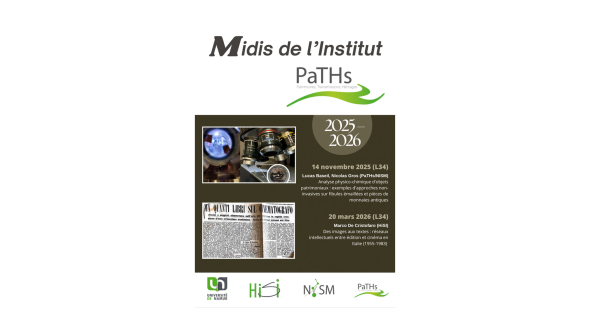The Patrimoines, Transmissions, Héritages (PaTHs) institute is a federation of research centers and groups that have sprung up in and around the Faculty of Philosophy and Letters in recent years.
The bringing together of researchers active in these groups should lead to the promotion of a diachronic approach to social and cultural phenomena in the broadest sense and also to intensified collaboration between "human sciences" ordinarily perceived as complementary, but whose research objects and methods in fact present a great heterogeneity.
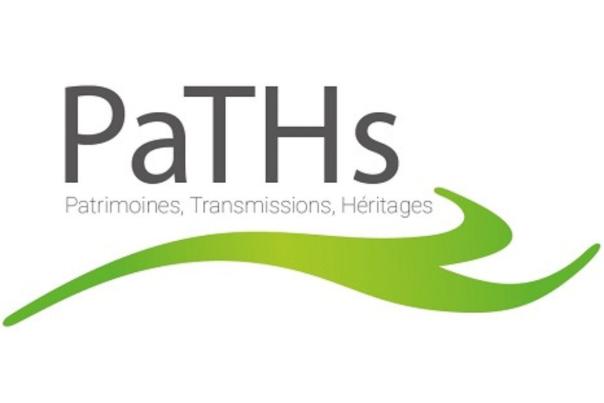
The PaTHs institute is distinguished by its emphasis on critical analysis of the "traces" of the past (written, material, monumental, landscape, visual, sound...), to the point of placing the "trace" itself at the heart of scientific questioning.
This epistemological orientation, inherited from a long tradition of research at UNamur, draws on fundamental disciplinary skills (historical criticism, philological criticism, methods of studying the built environment, etc.) to build effective methods of analysis that lead to innovative interpretations.
The very vigor of disciplinary know-how makes it possible - and this is a second specificity of PaTHs - to develop a range of innovative methods of analysis.
The very vigour of disciplinary know-how makes possible - and this is a second specificity of PaTHs - bold openings towards the exact sciences, which have already been initiated by most of the centers and groups affiliated to the institute. Witness LIATEC's and AcanthuM's collaborations with geologists, and PraME's with physicists and chemists.
Research centers
AcanthuM (Monumental, archaeological and artistic heritage)
See contentARaiRe (Recherches namuroises en histoire Rurale, 1500-1850)
See contentFontes Antiquitatis center
See contentHiSI research center (History, sounds and images)
See contentPratiques médiévales de l'écrit (PraME) research center
See contentSpotlight
News

Forgotten manuscripts tell the story of Christianization in the Middle Ages
Forgotten manuscripts tell the story of Christianization in the Middle Ages
Matthieu Pignot, researcher in the History Department and member of the PraME research center, has just been awarded the title of FNRS Qualified Researcher for his work on the transmission of religious knowledge between Antiquity and the Middle Ages. The originality of his research lies in the study of writings little or unknown to historians in the context of the Christianization of Europe.

To understand how the transition to Christianity came about, researchers generally turn to the great authors, and in particular Saint Augustine, the key figure of Christian antiquity whose writings have been preserved the most. Alongside his best-known works (such as The City of God or The Confessions), Saint Augustine is also the author of short treatises on practices such as marriage or baptism. "In my early post-doctoral research, I sought to understand how these short texts by Augustine, and other North African sources, circulated in the West between late antiquity and the early Middle Ages. This was a period of religious mixing when the first Christian communities were setting up systems of initiation and teaching", explains Matthieu Pignot.
Very quickly, the researcher's interest also turned to anonymous or pseudepigraphic texts (erroneously attributed to a known author), which had fallen into oblivion in favor of writings by authors, and which also addressed these questions of religious education. "This is the starting point for my research project. These texts are difficult to study because, circulating under several names, we don't know their true author. We don't know who wrote them, and we know little about their ancient and medieval transmission. It is precisely these grey areas that make them so interesting", continues the historian.
To address this question, Matthieu Pignot starts from two bodies of texts: on the one hand, a collection of 80 sermons wrongly attributed to Fulgence of Ruspe and, on the other, a Latin translation of an anonymous collection of Greek philosophical maxims by Rufinus of Aquileia (IV-Vth century), an author who played an important role in the transmission of Greek thought in late antiquity in the West.

These are humble, short and accessible texts that aim to convey a simple, rudimentary education. In this period of great change and the spread of Christianity as the dominant religion, these writings offer valuable clues to the evolution of religious education.
Bringing these writings to life with digital tools
The methodology favored by Matthieu Pignot for this research involves the use of digital publishing. The aim? "To bring into existence and enhance the value of these texts, which don't have the privilege of having an author's name, and some of which haven't even been printed. What's more, stylistic and linguistic analysis tools will perhaps make it possible to provide clues about the author, or at least to group texts together, based on recurring writing tics."
With this project, Matthieu Pignot also aims to develop the automated manuscript transcription component, which is still under development. "My aim is to contribute to the improvement of these tools through my own transcriptions and to participate in the dynamic of interest in medieval manuscripts in archives and libraries", concludes the researcher.
Express CV
Matthieu Pignot has an international background. Educated at UCLouvain, he specialized in the history of Antiquity and the Middle Ages. He continued his studies at the École Pratique des Hautes Études in Paris, then at Oxford University, where he defended his doctoral thesis. After his thesis, he participated in an ERC project on the cult of saints in the Western Christian world (Oxford University - Warsaw University).

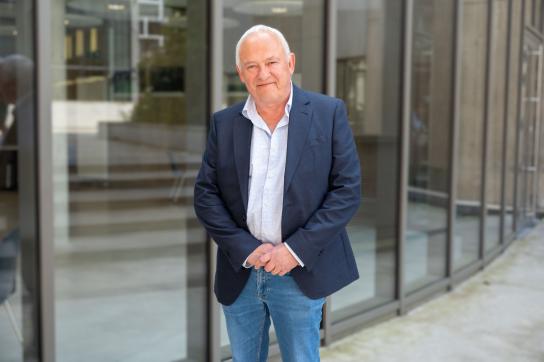
35 years between two accelerators - Serge Mathot's journey, or the art of welding history to physics
35 years between two accelerators - Serge Mathot's journey, or the art of welding history to physics
One foot in the past, the other in the future. From Etruscan granulation to PIXE analysis, Serge Mathot has built a unique career, between scientific heritage and particle accelerators. Portrait of a passionate alumnus at the crossroads of disciplines.
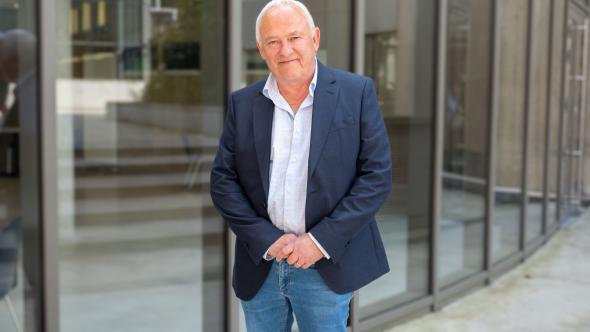
What prompted you to undertake your studies and then your doctorate in physics?
I was fascinated by the research field of one of my professors, Guy Demortier. He was working on the characterization of antique jewelry. He had found a way to differentiate by PIXE (Proton Induced X-ray Emission) analysis between antique and modern brazes that contained Cadmium, the presence of this element in antique jewelry being controversial at the time. He was interested in ancient soldering methods in general, and the granulation technique in particular. He studied them at the Laboratoire d'Analyses par Réaction Nucléaires (LARN). Brazing is an assembly operation involving the fusion of a filler metal (e.g. copper- or silver-based) without melting the base metal. This phenomenon allows a liquid metal to penetrate first by capillary action and then by diffusion at the interface of the metals to be joined, making the junction permanent after solidification. Among the jewels of antiquity, we find brazes made with incredible precision, the ancient techniques are fascinating.
Studying antique jewelry? Not what you'd expect in physics.
In fact, this was one of Namur's fields of research at the time: heritage sciences. Professor Demortier was conducting studies on a variety of jewels, but those made by the Etruscans using the so-called granulation technique, which first appeared in Eturia in the 8th century BC, are particularly incredible. It consists of depositing hundreds of tiny gold granules, up to two-tenths of a millimeter in diameter, on the surface to be decorated, and then soldering them onto the jewel without altering its fineness. So I also trained in brazing techniques and physical metallurgy.
The characterization of jewelry using LARN's particle accelerator, which enables non-destructive analysis, yields valuable information for heritage science.
This is, moreover, a current area of collaboration between the Department of Physics and the Department of History at UNamur (NDLR: notably through the ARC Phoenix project).
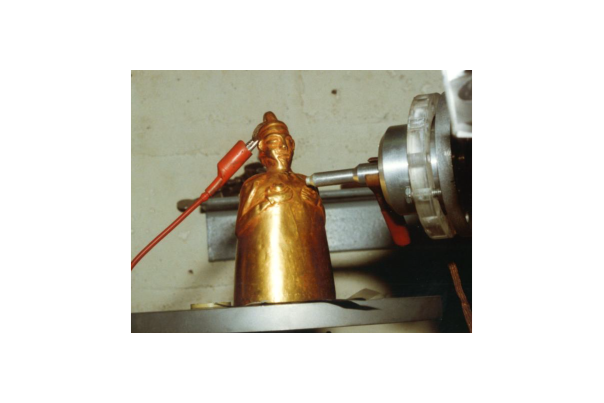
How did that help you land a job at CERN?
I applied for a position as a physicist at CERN in the field of vacuum and thin films, but was invited for the position of head of the vacuum brazing department. This department is very important for CERN as it studies methods for assembling particularly delicate and precise parts for accelerators. It also manufactures prototypes and often one-off parts. Broadly speaking, vacuum brazing is the same technique as the one we study at Namur, except that it is carried out in a vacuum chamber. This means no oxidation, perfect wetting of the brazing alloys on the parts to be assembled, and very precise temperature control to obtain very precise assemblies (we're talking microns!). I'd never heard of vacuum brazing, but my experience of Etruscan brazing, metallurgy and my background in applied physics as taught at Namur were of particular interest to the selection committee. They hired me right away!
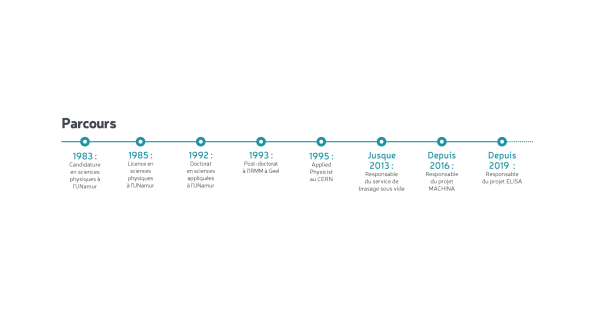
Tell us about CERN and the projects that keep you busy.
CERN is primarily known for hosting particle accelerators, including the famous LHC (Large Hadron Collider), a 27 km circumference accelerator buried some 100 m underground, which accelerates particles to 99.9999991% of the speed of light! CERN's research focuses on technology and innovation in many fields: nuclear physics, cosmic rays and cloud formation, antimatter research, the search for rare phenomena (such as the Higgs boson) and a contribution to neutrino research. It is also the birthplace of the World Wide Web (WWW). There are also projects in healthcare, medicine and partnerships with industry.
Nuclear physics at CERN is very different from what we do at UNamur with the ALTAÏS accelerator. But my training in applied physics (namuroise) has enabled me to integrate seamlessly into various research projects.
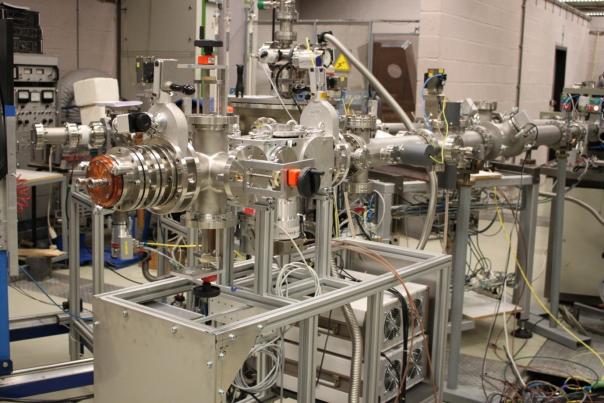
For my part, in addition to developing vacuum brazing methods, a field in which I've worked for over 20 years, I've worked a lot in parallel for the CLOUD experiment. For over 10 years, and until recently, I was its Technical Coordinator. CLOUD is a small but fascinating experiment at CERN which studies cloud formation and uses a particle beam to reproduce atomic bombardment in the laboratory in the manner of galactic radiation in our atmosphere. Using an ultra-clean 26 m³ cloud chamber, precise gas injection systems, electric fields, UV light systems and multiple detectors, we reproduce and study the Earth's atmosphere to understand whether galactic rays can indeed influence climate. This experiment calls on various fields of applied physics, and my background at UNamur has helped me once again.
I was also responsible for CERN's MACHINA project -Movable Accelerator for Cultural Heritage In situ Non-destructive Analysis - carried out in collaboration with the Istituto Nazionale di Fisica Nucleare (INFN), Florence section - Italy. Together, we have created the first portable proton accelerator for in-situ, non-destructive analysis in heritage science. MACHINA is soon to be used at the OPD (Opificio delle Pietre Dure), one of the oldest and most prestigious art restoration centers, also in Florence. The accelerator is also destined to travel to other museums or restoration centers.
Currently, I'm in charge of the ELISA (Experimental LInac for Surface Analysis) project. With ELISA, we're running a real proton accelerator for the first time in a place open to the public: the Science Gateway (SGW), CERN's new permanent exhibition center

ELISA uses the same accelerator cavity as MACHINA. The public can observe a proton beam extracted just a few centimetres from their eyes. Demonstrations are organized to show various physical phenomena, such as light production in gases or beam deflection with dipoles or quadrupoles, for example. The PIXE analysis method is also presented. ELISA is also a high-performance accelerator that we use for research projects in the field of heritage and others such as thin films, which are used extensively at CERN. The special feature is that the scientists who come to work with us do so in front of the public!
Do you have a story to tell?
I remember that in 1989, I finished typing my report for my IRSIA fellowship in the middle of the night, the day before the deadline. It had to be in by midnight the next day. There were very few computers back then, so I typed my report at the last minute on one of the secretaries' Macs. One false move and pow! all my data was gone - big panic! The next day, the secretary helped me restore my file, we printed out the document and I dropped it straight into the mailbox in Brussels, where I arrived after 11pm, in extremis, because at midnight, someone had come to close the mailbox. Fortunately, technology has come a long way since then...
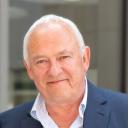
And I can't resist sharing two images 35 years apart!
To the left, a Gold statuette (Egypt), c. 2000 BC, analyzed at LARN - UNamur (photo 1990) and to the right, a copy (in Brass) of the Dame de Brassempouy, analyzed with ELISA - CERN (2025).
The "photographer" is the same, so we've come full circle...
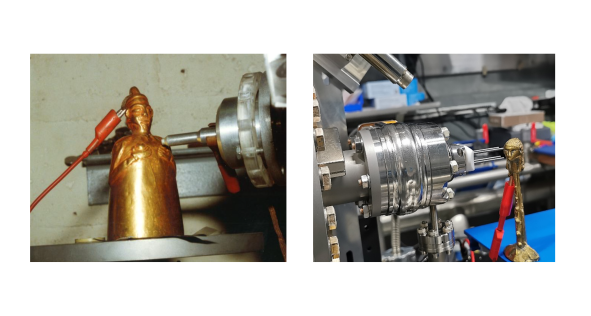
The proximity between teaching and research inspires and questions. This enables graduate students to move into multiple areas of working life.
Come and study in Namur!
Serge Mathot (May 2025) - Interview by Karin Derochette
Further information
- The CERN accelerators complex
- The Science Portal, CERN's public education and communication center
- Newsroom - June 2025 | The Departement of physics hosts a delegation from CERN
- Newsroom and Omalius Alumni article - September 2022 | François Briard
CERN - the science portal
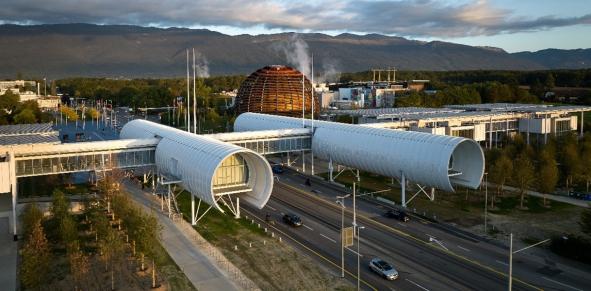
This article is taken from the "Alumni" section of Omalius magazine #38 (September 2025).
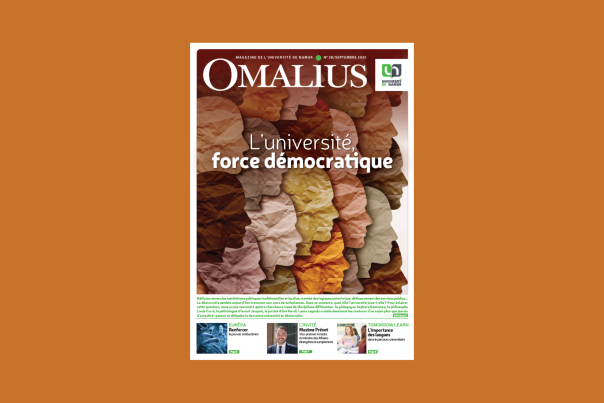
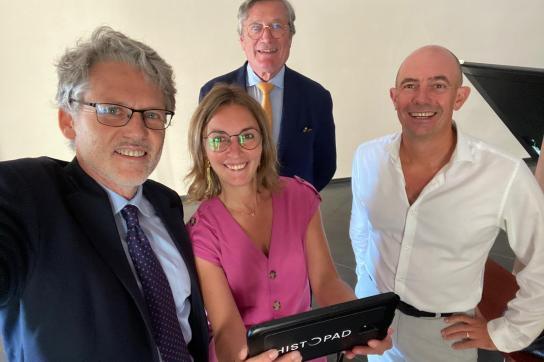
Axel Tixhon, scientific guarantor of a historic augmented reality project
Axel Tixhon, scientific guarantor of a historic augmented reality project
This is a first in Wallonia! The Citadelle de Dinant now offers an augmented reality tour that plunges visitors right into the heart of its history. At the helm: the French company Histovery, specializing in heritage reconstructions, with scientific support from Axel Tixhon, professor in the History Department at UNamur.
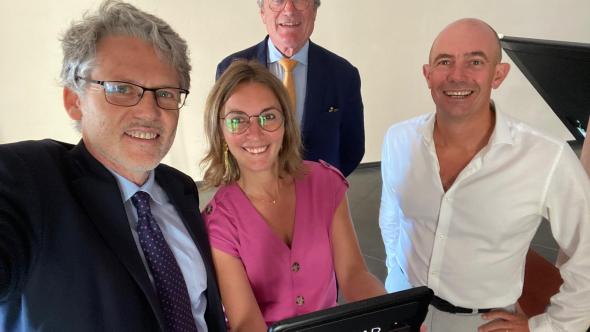
In the photo: Édouard Lecanuet, production assistant at Histovery, Minister Valérie Lescrenier in charge of Tourism and Heritage, Marc de Villenfagne, managing director of the Citadelle of Dinant, and Axel Tixhon, professor in the History Department at UNamur, inaugurate the HistoPad, a 3D reconstruction tool of the history of the Citadelle of Dinant. A project scientifically validated by Axel Tixhon.
Thanks to an interactive tablet christened HistoPad, the public can explore the site like never before. At various points along the route, visitors discover historical scenes recreated in 3D, supported by rigorous documentation and faithful reproductions of period settings, costumes and objects.
Three key periods have been selected for this immersion:
- 1821, Dutch period and construction of the fort
- 1832, Belgian period during which the Citadelle becomes a military prison
- 1914, during the First World War, the site is the scene of confrontations
Historical rigor at the service of innovation
Professor Tixhon was involved in all stages of the project, as a member of the scientific committee. Initially, he highlighted historically interesting events and traces still visible today, such as artillery pieces, an old kitchen or a bakery. It also provided Histovery with relevant and reliable documentation.
A faithful historical reconstruction, down to the smallest detail
His expertise has made it possible to assess the historical accuracy of the reconstructions.
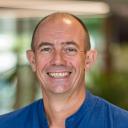
They asked me to validate details, such as the Dutch army uniforms or the handling of weapons," he explains. "We also had to avoid anachronisms. For example, the Histovery team had displayed an 1850 portrait of King Leopold I in the office of a fort commander in 1832. They had also displayed the current coats of arms of the 9 Belgian provinces, which didn't match the coats of arms of the time. So we had to find the right portrait and the right coats of arms.
The invisible recomposed through archives
Some locations have also been virtually recreated from ancient iconographic sources, such as an ingenious wooden mechanism that once carried water from the Meuse to the fortress.
Histovery, already known for its achievements at the Château de Chambord, the Palais de papes in Avignon and Fort Alamo in the USA, here signs a Walloon first, blending heritage, innovation and scientific rigor. A success that demonstrates, once again, the relevance of dialogue between experts at the University of Namur and socio-economic and cultural players.
.The Patrimoines, transmissions, héritages (PaTHs) institute
The Patrimoines, Transmissions, Héritages (PaTHs) institute is a federation of research centers and groups that have sprung up in and around the Faculty of Philosophy and Letters. The institute is made up of several research clusters. Axel Tixhon is a member of the HISI cluster (History, Sounds, Images).

UNamur History Department
As a discipline, history surveys the human past in all its complexity: populations, economies, techniques, politics, religions, arts, ideologies, etc.
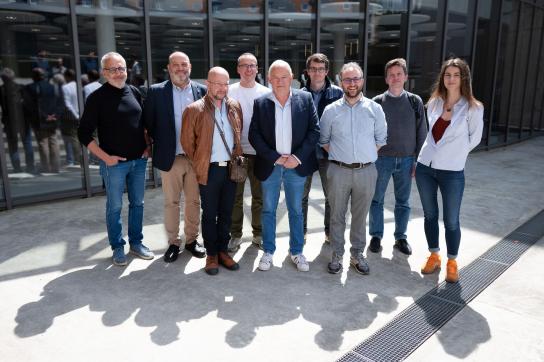
The Department of Physics welcomes a delegation from CERN
The Department of Physics welcomes a delegation from CERN
In May 2025, the Department of Physics welcomed two special visitors: Serge Mathot and François Briard from Namur, both alumni of UNamur and members of CERN. Several activities were on the program, ranging from a visit to the particle accelerator, to science popularization and thematic seminars, particularly in heritage sciences. The aim? To identify areas or activities in which UNamur and CERN could strengthen their collaboration.
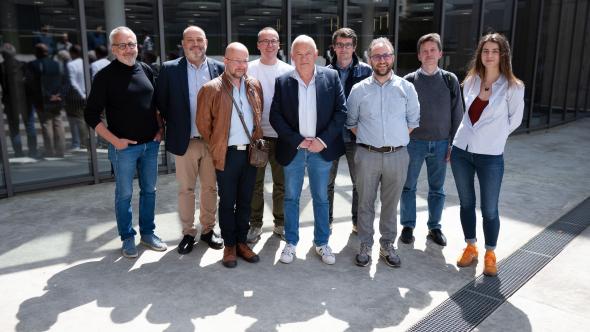
In the picture, from left to right: (top) Pierre Louette, Director of the Physics Department; François Briard, Head of the Science Portal Group (CERN); Julien Colaux, IBA specialist, physics researcher; Boris Hespeels, biology researcher; Alexandre Mayer, physics researcher; Anne-Catherine Heuskin, physics and biophysics researcher. (bottom) André Füzfa, astrophysicist and mathematics researcher; Serge Mathot, Applied Physicist (CERN) and Michaël Lobet, physics researcher.
The love affair between CERN and UNamur goes back a long way. CERN's accelerator complex and experimental program are very different and much larger than those of UNamur's Physics Department, but the fields in which the two institutions work have much in common.
In addition, both guests have a personal history with UNamur. The Physics Department was pleased to welcome Serge Mathot, Referent Applied Physicist (CERN) and alumni of the UNamur Physics Department (1992), as well as François Briard, Group Leader Science Portal (CERN), and alumni of the UNamur Faculty of Computer Science (1994).
The activities began with a meeting between the guests, Rector Annick Castiaux, Vice-Rector for Research Carine Michiels, Physics Department Director Pierre Louette and several other members of the Physics and Biology Department. After a general presentation of the University, the participants pointed out the missions shared by both institutions: research and the transfer of technology and knowledge, service to society, scientific popularization and education and training.
.
Focus on meetings
Physics lunch - CERN presentation
The physics lunch is the monthly meeting between students and members of the physics department and a professional, alumni or not, coming to explain his or her background and what he or she does on a daily basis as a physicist.
During this meeting, attended by around 80 people, François Briard and Serge Mathot presented CERN, the world's largest laboratory for particle physics. CERN's mission is to understand the most elementary particles and the laws of our universe.
At the end of the seminar, the students came away with stars in their eyes. Indeed, opportunities for internships or even first jobs at CERN are possible for physicists but also in many other fields.
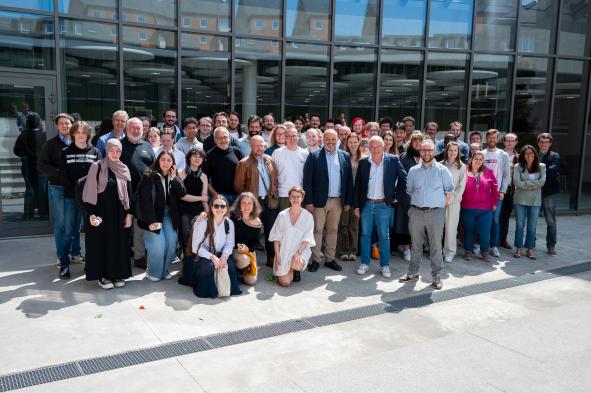

Your physics training at UNamur is your best ticket to a job at CERN. It's more than just a degree in particle physics!
Some internship programs at CERN are particularly well suited to the needs of young Belgian students.
The vast majority of physicists working with CERN (over 13,000) are in fact sent to CERN for varying periods of time by their employing national research institutes. CERN offers an exceptional opportunity to develop international experience under excellent conditions, in an environment that is unique in the world! What an inspiration for our young students!
Visit of the ALTAÏS and SIAM facilities
Capable of generating ion beams consisting of any stable element with energies of up to 16 Mega electron-Volt (MeV), the ALTAÏS particle accelerator is used in various fields of fundamental and applied research, notably through industrial partnerships. CERN's largest current linear accelerator can produce particle beams of up to 160 MeV.
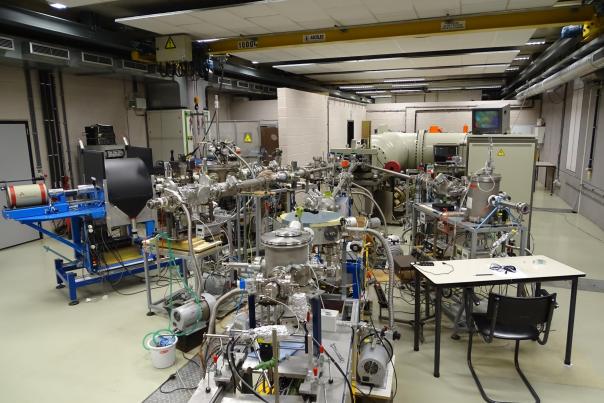
Meeting with members of the ARC PHOENIX project, complemented by a heritage science seminar given by Serge Mathot.
The projet d'Action Recherche Concertée (ARC) PHOENIX aims to renew our understanding of medieval parchments and ancient coins. Artificial intelligence will be exploited to analyze the data generated by material characterization.
This joint study between the Department of Physics and the Namur Institute of Structured Matter (NISM) and the Department of History and the Institut Patrimoines, Transmissions, Héritages (PaTHs) will address questions relating to the production chain and use of these objects and materials in past societies.
At the same time, Serge Mathot presented a seminar in heritage science attended by some 50 people. In particular, he presented his research and the brand-new ELISA accelerator: a miniaturized gas pedal capable of delivering a 2 MeV proton beam used to perform real measurements at the Science Portal.
Meeting on science popularization
Having the opportunity to exchange views with François Briard, Group Leader of the CERN Science Portal is a rare opportunity. Comparing outreach activities has opened up new avenues, discovering and sharing approaches, assessing what works and what doesn't, depending on the target audience. A highly satisfying enrichment for the members present from Confluent des Savoirs (CDS), the University of Namur's research outreach and dissemination service.
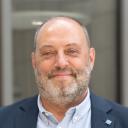
The CERN Science Portal is a place where you can explore CERN and science through authentic and innovative experiences: immersive multimedia exhibitions, hands-on lab workshops, science shows, events combining science and culture, prototyping workshops on the theme of innovation, tours of CERN sites, all accompanied by CERN staff.
BD Physix - Energy
Teachers André Füzfa and Michaël Lobet were able to present the comic strip project created with author Jean-Marc Dubois.
The theme? Energy!
What could be more natural than to talk about it with François Briard, chief popularizer at CERN, who is interested in this popularization project in a medium accessible to people aged 7 to 77!
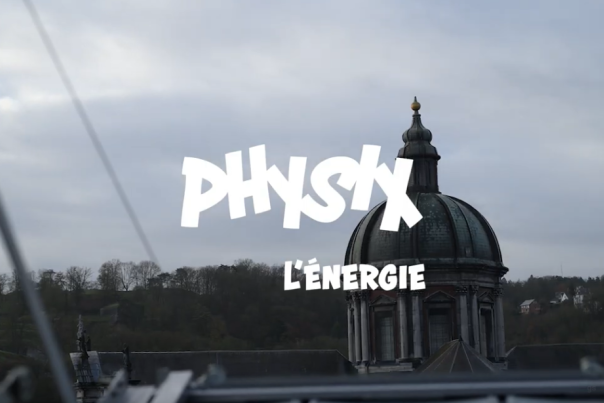
Meeting on the theme of biophysics
Professor Anne-Catherine Heuskin and Dr. Boris Hespeels are currently working on the BEBLOB project, a Belspo project with ESA support, as part of the UNIVERSEH (European Space University for Earth and Humanity) alliance. They are particularly interested in its astonishing ability to withstand high doses of radiation.
Anne-Catherine Heuskin also works in radiobiology. Particles are used to irradiate cancerous cells in order to destroy their genetic material and prevent them from proliferating: this is the basis of radiotherapy and proton therapy.
Meeting with FaSEF regarding teacher training opportunities.
The meeting confirmed the willingness of FaSEF and UNamur to get involved in coordinating the Belgian National Teacher Programme in French-speaking Belgium, which CERN intends to relaunch in 2026. Consideration was also given to other avenues for teacher training, such as CERN's forthcoming involvement in the "Salle des Pros", the training venue for the various players involved in teacher training at UNamur.
.A visit to TRAKK
The TRAKK is Namur's creative hub supported by 3 complementary partners in the field: BEP, KIKK, and UNamur. In addition to the venue, François Briard was able to visit the ProtoLab , which bridges the gap between ideas and industry by being a decentralized research and development hub accessible to SMEs and project leaders by offering advanced support in prototyping products or services.
Guests at CERN
François Briard - CERN Science Portal Group Leader, UNamur alumni 1994
Specialities:
- Information systems, administrative applications and databases (Oracle)
- Communications for the general public
- Visitor reception logistics
- Event organization for up to 80,000 participants.
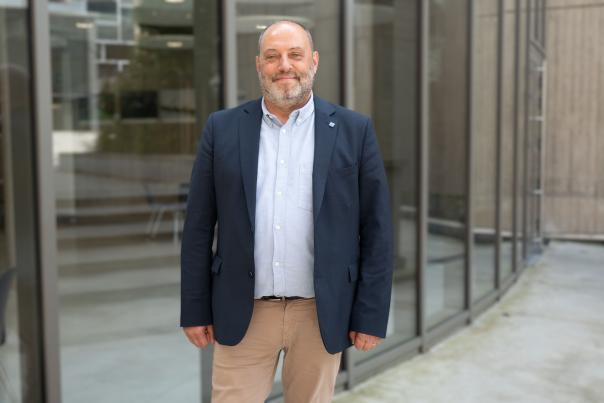
Graduating in law and information technology management (DGTIC) in 1994 after his bachelor's and master's degrees in computer science in 1993, François Briard works at CERN, the European Organization for Nuclear Research in Geneva, the world's largest particle physics laboratory.
During his school career, which was 100% at UNamur, he was vice-president of the Régionale namuroise and student delegate during his years as a candidate in economic and social sciences, computer science option.
Thanks to the multidisciplinary training provided at UNamur, he was able to seize several opportunities to redirect his career at CERN, where he was an information systems engineer from 1994 and then, from 2014, redirected his career until he became Group Leader of the Science Portal, which is CERN's general public communications center.
Serge Mathot - Referent Applied Physicist at CERN, UNamur alumni 1992
His specialties
- Ion Beam Analysis (IBA)
- Metallurgy, vacuum brazing
- Radio-Frequency Quadrupole (RFQ) linacs, ion sources
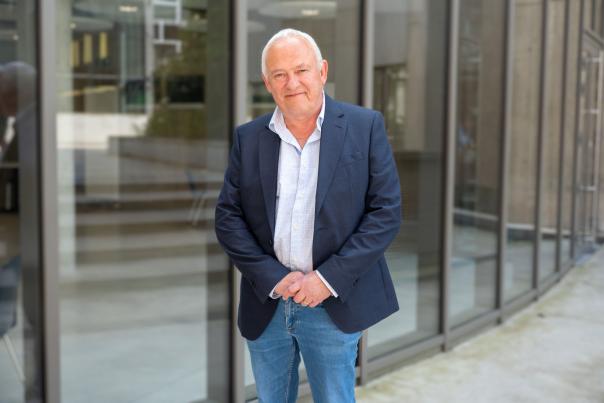
Serge Mathot obtained his doctorate in applied sciences from UNamur in 1992, following his bachelor's degree in physical sciences in 1985.
He then carried out a post-doctorate at the Joint Research Center (EU science hub) in Geel, which aims to bring together multidisciplinary skills to develop new measurement methods and tools such as reference materials.
He perfected his expertise in physical metallurgy before joining CERN in 1995 as a Referent Applied Physicist. He has worked on numerous research projects (CLOUD, MACHINA, ELISA...) and developed numerous parts for the manufacture of CERN's gas pedals.
It's a great pleasure to meet him.CERN
CERN, the European Organization for Nuclear Research, is one of the world's largest and most prestigious scientific laboratories. Its vocation is fundamental physics, the discovery of the constituents and laws of the Universe. It uses highly complex scientific instruments to probe the ultimate constituents of matter: the fundamental particles. By studying what happens when these particles collide, physicists understand the laws of Nature.
The instruments used at CERN are particle gas pedals and detectors. Gas pedals carry beams of particles at high energies to collide with other beams or fixed targets. Detectors observe and record the results of these collisions.
Founded in 1954, CERN is located on either side of the French-Swiss border, near Geneva. It was one of the first organizations on a European scale and today has 25 member states, including Belgium.
Physics programs at UNamur
From the infinitely small to the infinitely large, from elementary particles to galaxies, are you thirsty to understand the whys and wherefores of the natural phenomena you observe? Physics answers all your questions.

Forgotten manuscripts tell the story of Christianization in the Middle Ages
Forgotten manuscripts tell the story of Christianization in the Middle Ages
Matthieu Pignot, researcher in the History Department and member of the PraME research center, has just been awarded the title of FNRS Qualified Researcher for his work on the transmission of religious knowledge between Antiquity and the Middle Ages. The originality of his research lies in the study of writings little or unknown to historians in the context of the Christianization of Europe.

To understand how the transition to Christianity came about, researchers generally turn to the great authors, and in particular Saint Augustine, the key figure of Christian antiquity whose writings have been preserved the most. Alongside his best-known works (such as The City of God or The Confessions), Saint Augustine is also the author of short treatises on practices such as marriage or baptism. "In my early post-doctoral research, I sought to understand how these short texts by Augustine, and other North African sources, circulated in the West between late antiquity and the early Middle Ages. This was a period of religious mixing when the first Christian communities were setting up systems of initiation and teaching", explains Matthieu Pignot.
Very quickly, the researcher's interest also turned to anonymous or pseudepigraphic texts (erroneously attributed to a known author), which had fallen into oblivion in favor of writings by authors, and which also addressed these questions of religious education. "This is the starting point for my research project. These texts are difficult to study because, circulating under several names, we don't know their true author. We don't know who wrote them, and we know little about their ancient and medieval transmission. It is precisely these grey areas that make them so interesting", continues the historian.
To address this question, Matthieu Pignot starts from two bodies of texts: on the one hand, a collection of 80 sermons wrongly attributed to Fulgence of Ruspe and, on the other, a Latin translation of an anonymous collection of Greek philosophical maxims by Rufinus of Aquileia (IV-Vth century), an author who played an important role in the transmission of Greek thought in late antiquity in the West.

These are humble, short and accessible texts that aim to convey a simple, rudimentary education. In this period of great change and the spread of Christianity as the dominant religion, these writings offer valuable clues to the evolution of religious education.
Bringing these writings to life with digital tools
The methodology favored by Matthieu Pignot for this research involves the use of digital publishing. The aim? "To bring into existence and enhance the value of these texts, which don't have the privilege of having an author's name, and some of which haven't even been printed. What's more, stylistic and linguistic analysis tools will perhaps make it possible to provide clues about the author, or at least to group texts together, based on recurring writing tics."
With this project, Matthieu Pignot also aims to develop the automated manuscript transcription component, which is still under development. "My aim is to contribute to the improvement of these tools through my own transcriptions and to participate in the dynamic of interest in medieval manuscripts in archives and libraries", concludes the researcher.
Express CV
Matthieu Pignot has an international background. Educated at UCLouvain, he specialized in the history of Antiquity and the Middle Ages. He continued his studies at the École Pratique des Hautes Études in Paris, then at Oxford University, where he defended his doctoral thesis. After his thesis, he participated in an ERC project on the cult of saints in the Western Christian world (Oxford University - Warsaw University).


35 years between two accelerators - Serge Mathot's journey, or the art of welding history to physics
35 years between two accelerators - Serge Mathot's journey, or the art of welding history to physics
One foot in the past, the other in the future. From Etruscan granulation to PIXE analysis, Serge Mathot has built a unique career, between scientific heritage and particle accelerators. Portrait of a passionate alumnus at the crossroads of disciplines.

What prompted you to undertake your studies and then your doctorate in physics?
I was fascinated by the research field of one of my professors, Guy Demortier. He was working on the characterization of antique jewelry. He had found a way to differentiate by PIXE (Proton Induced X-ray Emission) analysis between antique and modern brazes that contained Cadmium, the presence of this element in antique jewelry being controversial at the time. He was interested in ancient soldering methods in general, and the granulation technique in particular. He studied them at the Laboratoire d'Analyses par Réaction Nucléaires (LARN). Brazing is an assembly operation involving the fusion of a filler metal (e.g. copper- or silver-based) without melting the base metal. This phenomenon allows a liquid metal to penetrate first by capillary action and then by diffusion at the interface of the metals to be joined, making the junction permanent after solidification. Among the jewels of antiquity, we find brazes made with incredible precision, the ancient techniques are fascinating.
Studying antique jewelry? Not what you'd expect in physics.
In fact, this was one of Namur's fields of research at the time: heritage sciences. Professor Demortier was conducting studies on a variety of jewels, but those made by the Etruscans using the so-called granulation technique, which first appeared in Eturia in the 8th century BC, are particularly incredible. It consists of depositing hundreds of tiny gold granules, up to two-tenths of a millimeter in diameter, on the surface to be decorated, and then soldering them onto the jewel without altering its fineness. So I also trained in brazing techniques and physical metallurgy.
The characterization of jewelry using LARN's particle accelerator, which enables non-destructive analysis, yields valuable information for heritage science.
This is, moreover, a current area of collaboration between the Department of Physics and the Department of History at UNamur (NDLR: notably through the ARC Phoenix project).

How did that help you land a job at CERN?
I applied for a position as a physicist at CERN in the field of vacuum and thin films, but was invited for the position of head of the vacuum brazing department. This department is very important for CERN as it studies methods for assembling particularly delicate and precise parts for accelerators. It also manufactures prototypes and often one-off parts. Broadly speaking, vacuum brazing is the same technique as the one we study at Namur, except that it is carried out in a vacuum chamber. This means no oxidation, perfect wetting of the brazing alloys on the parts to be assembled, and very precise temperature control to obtain very precise assemblies (we're talking microns!). I'd never heard of vacuum brazing, but my experience of Etruscan brazing, metallurgy and my background in applied physics as taught at Namur were of particular interest to the selection committee. They hired me right away!

Tell us about CERN and the projects that keep you busy.
CERN is primarily known for hosting particle accelerators, including the famous LHC (Large Hadron Collider), a 27 km circumference accelerator buried some 100 m underground, which accelerates particles to 99.9999991% of the speed of light! CERN's research focuses on technology and innovation in many fields: nuclear physics, cosmic rays and cloud formation, antimatter research, the search for rare phenomena (such as the Higgs boson) and a contribution to neutrino research. It is also the birthplace of the World Wide Web (WWW). There are also projects in healthcare, medicine and partnerships with industry.
Nuclear physics at CERN is very different from what we do at UNamur with the ALTAÏS accelerator. But my training in applied physics (namuroise) has enabled me to integrate seamlessly into various research projects.

For my part, in addition to developing vacuum brazing methods, a field in which I've worked for over 20 years, I've worked a lot in parallel for the CLOUD experiment. For over 10 years, and until recently, I was its Technical Coordinator. CLOUD is a small but fascinating experiment at CERN which studies cloud formation and uses a particle beam to reproduce atomic bombardment in the laboratory in the manner of galactic radiation in our atmosphere. Using an ultra-clean 26 m³ cloud chamber, precise gas injection systems, electric fields, UV light systems and multiple detectors, we reproduce and study the Earth's atmosphere to understand whether galactic rays can indeed influence climate. This experiment calls on various fields of applied physics, and my background at UNamur has helped me once again.
I was also responsible for CERN's MACHINA project -Movable Accelerator for Cultural Heritage In situ Non-destructive Analysis - carried out in collaboration with the Istituto Nazionale di Fisica Nucleare (INFN), Florence section - Italy. Together, we have created the first portable proton accelerator for in-situ, non-destructive analysis in heritage science. MACHINA is soon to be used at the OPD (Opificio delle Pietre Dure), one of the oldest and most prestigious art restoration centers, also in Florence. The accelerator is also destined to travel to other museums or restoration centers.
Currently, I'm in charge of the ELISA (Experimental LInac for Surface Analysis) project. With ELISA, we're running a real proton accelerator for the first time in a place open to the public: the Science Gateway (SGW), CERN's new permanent exhibition center

ELISA uses the same accelerator cavity as MACHINA. The public can observe a proton beam extracted just a few centimetres from their eyes. Demonstrations are organized to show various physical phenomena, such as light production in gases or beam deflection with dipoles or quadrupoles, for example. The PIXE analysis method is also presented. ELISA is also a high-performance accelerator that we use for research projects in the field of heritage and others such as thin films, which are used extensively at CERN. The special feature is that the scientists who come to work with us do so in front of the public!
Do you have a story to tell?
I remember that in 1989, I finished typing my report for my IRSIA fellowship in the middle of the night, the day before the deadline. It had to be in by midnight the next day. There were very few computers back then, so I typed my report at the last minute on one of the secretaries' Macs. One false move and pow! all my data was gone - big panic! The next day, the secretary helped me restore my file, we printed out the document and I dropped it straight into the mailbox in Brussels, where I arrived after 11pm, in extremis, because at midnight, someone had come to close the mailbox. Fortunately, technology has come a long way since then...

And I can't resist sharing two images 35 years apart!
To the left, a Gold statuette (Egypt), c. 2000 BC, analyzed at LARN - UNamur (photo 1990) and to the right, a copy (in Brass) of the Dame de Brassempouy, analyzed with ELISA - CERN (2025).
The "photographer" is the same, so we've come full circle...

The proximity between teaching and research inspires and questions. This enables graduate students to move into multiple areas of working life.
Come and study in Namur!
Serge Mathot (May 2025) - Interview by Karin Derochette
Further information
- The CERN accelerators complex
- The Science Portal, CERN's public education and communication center
- Newsroom - June 2025 | The Departement of physics hosts a delegation from CERN
- Newsroom and Omalius Alumni article - September 2022 | François Briard
CERN - the science portal

This article is taken from the "Alumni" section of Omalius magazine #38 (September 2025).


Axel Tixhon, scientific guarantor of a historic augmented reality project
Axel Tixhon, scientific guarantor of a historic augmented reality project
This is a first in Wallonia! The Citadelle de Dinant now offers an augmented reality tour that plunges visitors right into the heart of its history. At the helm: the French company Histovery, specializing in heritage reconstructions, with scientific support from Axel Tixhon, professor in the History Department at UNamur.

In the photo: Édouard Lecanuet, production assistant at Histovery, Minister Valérie Lescrenier in charge of Tourism and Heritage, Marc de Villenfagne, managing director of the Citadelle of Dinant, and Axel Tixhon, professor in the History Department at UNamur, inaugurate the HistoPad, a 3D reconstruction tool of the history of the Citadelle of Dinant. A project scientifically validated by Axel Tixhon.
Thanks to an interactive tablet christened HistoPad, the public can explore the site like never before. At various points along the route, visitors discover historical scenes recreated in 3D, supported by rigorous documentation and faithful reproductions of period settings, costumes and objects.
Three key periods have been selected for this immersion:
- 1821, Dutch period and construction of the fort
- 1832, Belgian period during which the Citadelle becomes a military prison
- 1914, during the First World War, the site is the scene of confrontations
Historical rigor at the service of innovation
Professor Tixhon was involved in all stages of the project, as a member of the scientific committee. Initially, he highlighted historically interesting events and traces still visible today, such as artillery pieces, an old kitchen or a bakery. It also provided Histovery with relevant and reliable documentation.
A faithful historical reconstruction, down to the smallest detail
His expertise has made it possible to assess the historical accuracy of the reconstructions.

They asked me to validate details, such as the Dutch army uniforms or the handling of weapons," he explains. "We also had to avoid anachronisms. For example, the Histovery team had displayed an 1850 portrait of King Leopold I in the office of a fort commander in 1832. They had also displayed the current coats of arms of the 9 Belgian provinces, which didn't match the coats of arms of the time. So we had to find the right portrait and the right coats of arms.
The invisible recomposed through archives
Some locations have also been virtually recreated from ancient iconographic sources, such as an ingenious wooden mechanism that once carried water from the Meuse to the fortress.
Histovery, already known for its achievements at the Château de Chambord, the Palais de papes in Avignon and Fort Alamo in the USA, here signs a Walloon first, blending heritage, innovation and scientific rigor. A success that demonstrates, once again, the relevance of dialogue between experts at the University of Namur and socio-economic and cultural players.
.The Patrimoines, transmissions, héritages (PaTHs) institute
The Patrimoines, Transmissions, Héritages (PaTHs) institute is a federation of research centers and groups that have sprung up in and around the Faculty of Philosophy and Letters. The institute is made up of several research clusters. Axel Tixhon is a member of the HISI cluster (History, Sounds, Images).

UNamur History Department
As a discipline, history surveys the human past in all its complexity: populations, economies, techniques, politics, religions, arts, ideologies, etc.

The Department of Physics welcomes a delegation from CERN
The Department of Physics welcomes a delegation from CERN
In May 2025, the Department of Physics welcomed two special visitors: Serge Mathot and François Briard from Namur, both alumni of UNamur and members of CERN. Several activities were on the program, ranging from a visit to the particle accelerator, to science popularization and thematic seminars, particularly in heritage sciences. The aim? To identify areas or activities in which UNamur and CERN could strengthen their collaboration.

In the picture, from left to right: (top) Pierre Louette, Director of the Physics Department; François Briard, Head of the Science Portal Group (CERN); Julien Colaux, IBA specialist, physics researcher; Boris Hespeels, biology researcher; Alexandre Mayer, physics researcher; Anne-Catherine Heuskin, physics and biophysics researcher. (bottom) André Füzfa, astrophysicist and mathematics researcher; Serge Mathot, Applied Physicist (CERN) and Michaël Lobet, physics researcher.
The love affair between CERN and UNamur goes back a long way. CERN's accelerator complex and experimental program are very different and much larger than those of UNamur's Physics Department, but the fields in which the two institutions work have much in common.
In addition, both guests have a personal history with UNamur. The Physics Department was pleased to welcome Serge Mathot, Referent Applied Physicist (CERN) and alumni of the UNamur Physics Department (1992), as well as François Briard, Group Leader Science Portal (CERN), and alumni of the UNamur Faculty of Computer Science (1994).
The activities began with a meeting between the guests, Rector Annick Castiaux, Vice-Rector for Research Carine Michiels, Physics Department Director Pierre Louette and several other members of the Physics and Biology Department. After a general presentation of the University, the participants pointed out the missions shared by both institutions: research and the transfer of technology and knowledge, service to society, scientific popularization and education and training.
.
Focus on meetings
Physics lunch - CERN presentation
The physics lunch is the monthly meeting between students and members of the physics department and a professional, alumni or not, coming to explain his or her background and what he or she does on a daily basis as a physicist.
During this meeting, attended by around 80 people, François Briard and Serge Mathot presented CERN, the world's largest laboratory for particle physics. CERN's mission is to understand the most elementary particles and the laws of our universe.
At the end of the seminar, the students came away with stars in their eyes. Indeed, opportunities for internships or even first jobs at CERN are possible for physicists but also in many other fields.


Your physics training at UNamur is your best ticket to a job at CERN. It's more than just a degree in particle physics!
Some internship programs at CERN are particularly well suited to the needs of young Belgian students.
The vast majority of physicists working with CERN (over 13,000) are in fact sent to CERN for varying periods of time by their employing national research institutes. CERN offers an exceptional opportunity to develop international experience under excellent conditions, in an environment that is unique in the world! What an inspiration for our young students!
Visit of the ALTAÏS and SIAM facilities
Capable of generating ion beams consisting of any stable element with energies of up to 16 Mega electron-Volt (MeV), the ALTAÏS particle accelerator is used in various fields of fundamental and applied research, notably through industrial partnerships. CERN's largest current linear accelerator can produce particle beams of up to 160 MeV.

Meeting with members of the ARC PHOENIX project, complemented by a heritage science seminar given by Serge Mathot.
The projet d'Action Recherche Concertée (ARC) PHOENIX aims to renew our understanding of medieval parchments and ancient coins. Artificial intelligence will be exploited to analyze the data generated by material characterization.
This joint study between the Department of Physics and the Namur Institute of Structured Matter (NISM) and the Department of History and the Institut Patrimoines, Transmissions, Héritages (PaTHs) will address questions relating to the production chain and use of these objects and materials in past societies.
At the same time, Serge Mathot presented a seminar in heritage science attended by some 50 people. In particular, he presented his research and the brand-new ELISA accelerator: a miniaturized gas pedal capable of delivering a 2 MeV proton beam used to perform real measurements at the Science Portal.
Meeting on science popularization
Having the opportunity to exchange views with François Briard, Group Leader of the CERN Science Portal is a rare opportunity. Comparing outreach activities has opened up new avenues, discovering and sharing approaches, assessing what works and what doesn't, depending on the target audience. A highly satisfying enrichment for the members present from Confluent des Savoirs (CDS), the University of Namur's research outreach and dissemination service.

The CERN Science Portal is a place where you can explore CERN and science through authentic and innovative experiences: immersive multimedia exhibitions, hands-on lab workshops, science shows, events combining science and culture, prototyping workshops on the theme of innovation, tours of CERN sites, all accompanied by CERN staff.
BD Physix - Energy
Teachers André Füzfa and Michaël Lobet were able to present the comic strip project created with author Jean-Marc Dubois.
The theme? Energy!
What could be more natural than to talk about it with François Briard, chief popularizer at CERN, who is interested in this popularization project in a medium accessible to people aged 7 to 77!

Meeting on the theme of biophysics
Professor Anne-Catherine Heuskin and Dr. Boris Hespeels are currently working on the BEBLOB project, a Belspo project with ESA support, as part of the UNIVERSEH (European Space University for Earth and Humanity) alliance. They are particularly interested in its astonishing ability to withstand high doses of radiation.
Anne-Catherine Heuskin also works in radiobiology. Particles are used to irradiate cancerous cells in order to destroy their genetic material and prevent them from proliferating: this is the basis of radiotherapy and proton therapy.
Meeting with FaSEF regarding teacher training opportunities.
The meeting confirmed the willingness of FaSEF and UNamur to get involved in coordinating the Belgian National Teacher Programme in French-speaking Belgium, which CERN intends to relaunch in 2026. Consideration was also given to other avenues for teacher training, such as CERN's forthcoming involvement in the "Salle des Pros", the training venue for the various players involved in teacher training at UNamur.
.A visit to TRAKK
The TRAKK is Namur's creative hub supported by 3 complementary partners in the field: BEP, KIKK, and UNamur. In addition to the venue, François Briard was able to visit the ProtoLab , which bridges the gap between ideas and industry by being a decentralized research and development hub accessible to SMEs and project leaders by offering advanced support in prototyping products or services.
Guests at CERN
François Briard - CERN Science Portal Group Leader, UNamur alumni 1994
Specialities:
- Information systems, administrative applications and databases (Oracle)
- Communications for the general public
- Visitor reception logistics
- Event organization for up to 80,000 participants.

Graduating in law and information technology management (DGTIC) in 1994 after his bachelor's and master's degrees in computer science in 1993, François Briard works at CERN, the European Organization for Nuclear Research in Geneva, the world's largest particle physics laboratory.
During his school career, which was 100% at UNamur, he was vice-president of the Régionale namuroise and student delegate during his years as a candidate in economic and social sciences, computer science option.
Thanks to the multidisciplinary training provided at UNamur, he was able to seize several opportunities to redirect his career at CERN, where he was an information systems engineer from 1994 and then, from 2014, redirected his career until he became Group Leader of the Science Portal, which is CERN's general public communications center.
Serge Mathot - Referent Applied Physicist at CERN, UNamur alumni 1992
His specialties
- Ion Beam Analysis (IBA)
- Metallurgy, vacuum brazing
- Radio-Frequency Quadrupole (RFQ) linacs, ion sources

Serge Mathot obtained his doctorate in applied sciences from UNamur in 1992, following his bachelor's degree in physical sciences in 1985.
He then carried out a post-doctorate at the Joint Research Center (EU science hub) in Geel, which aims to bring together multidisciplinary skills to develop new measurement methods and tools such as reference materials.
He perfected his expertise in physical metallurgy before joining CERN in 1995 as a Referent Applied Physicist. He has worked on numerous research projects (CLOUD, MACHINA, ELISA...) and developed numerous parts for the manufacture of CERN's gas pedals.
It's a great pleasure to meet him.CERN
CERN, the European Organization for Nuclear Research, is one of the world's largest and most prestigious scientific laboratories. Its vocation is fundamental physics, the discovery of the constituents and laws of the Universe. It uses highly complex scientific instruments to probe the ultimate constituents of matter: the fundamental particles. By studying what happens when these particles collide, physicists understand the laws of Nature.
The instruments used at CERN are particle gas pedals and detectors. Gas pedals carry beams of particles at high energies to collide with other beams or fixed targets. Detectors observe and record the results of these collisions.
Founded in 1954, CERN is located on either side of the French-Swiss border, near Geneva. It was one of the first organizations on a European scale and today has 25 member states, including Belgium.
Physics programs at UNamur
From the infinitely small to the infinitely large, from elementary particles to galaxies, are you thirsty to understand the whys and wherefores of the natural phenomena you observe? Physics answers all your questions.
Agenda
Laetitia Ciccolini (Sorbonne University)
Augustine's Enchiridion through its summaries: circulation, reception, uses
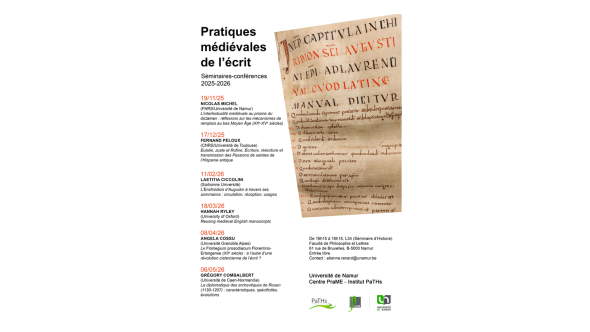
Hannah Ryley (University of Oxford)
Reusing medieval English manuscripts

Midi de PaTHs | From images to texts: intellectual networks between publishing and cinema in Italy (1955-1983)
Speaker: Marco De Cristofaro (History, HiSI)
